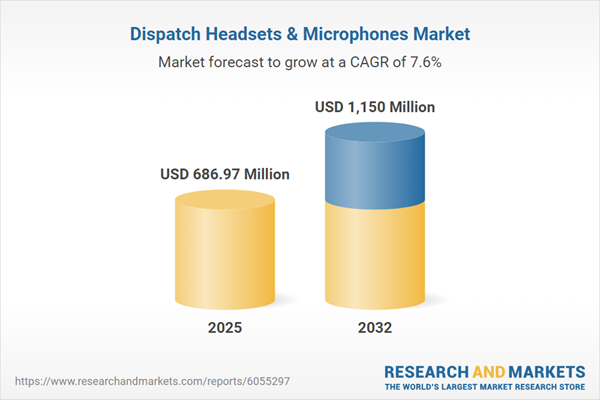Speak directly to the analyst to clarify any post sales queries you may have.
The dispatch headsets and microphones market is evolving rapidly as organizations across industries pursue communication systems that support operational precision and robust reliability in challenging environments. Senior leaders evaluating this segment should understand current trends, technological shifts, and regulatory dynamics shaping these solutions.
Market Snapshot: Dispatch Headsets & Microphones Market Overview
The Dispatch Headsets & Microphones Market grew from USD 641.31 million in 2024 to USD 686.97 million in 2025. It is expected to continue growing at a CAGR of 7.58%, reaching USD 1.15 billion by 2032. Organizations in public safety, utilities, transportation, and related sectors are driving demand for advanced audio solutions with enhanced performance, clarity, and integration. The increasing role of digital platforms, regulatory compliance, and emerging operational needs position this market for sustained growth.
Scope & Segmentation: Comprehensive Coverage of Dispatch Communications
- Product Types: Headsets (dual-sided, single-sided), Microphones (omnidirectional, unidirectional).
- Connectivity Options: Wired, Wireless.
- Technology Types: Analog, Digital.
- Applications: Call Centers, Public Safety, Transportation (Aviation, Maritime, Railways), Utilities (Oil & Gas, Power, Water).
- End-User Groups: Individual Consumers, Organizations.
- Distribution Channels: Offline, Online (Brand Websites, E-Commerce Platforms).
- Regional Coverage: Americas, Europe, Middle East & Africa, Asia-Pacific, including country-specific analysis for North America, Latin America, Europe, Middle East, Africa, and Asia-Pacific sub-regions.
- Key Companies Analyzed: AKG Acoustics by HARMAN, Bose Corporation, Clear Choice Headsets & Technology, Corsair Gaming, Cyber Acoustics, David Clark Company, Dell Technologies, GN Audio A/S, Hytera Communications, Infineon Technologies, Koss Corporation, LEXAIR, Lightspeed Aviation, Logitech, Motorola Solutions, N•EAR, Orion Systems, Secure Headset Group, Sencommunications, Sennheiser electronic, Sonetics Corporation, Tait Communications, Telex Communications by Bosch, ZYCOO.
Key Takeaways: Strategic Insights for Senior Decision Makers
- Technological advancement in digital audio processing, noise suppression, and wireless protocols is driving operational enhancements for dispatch communication environments.
- Demand is intensifying for dispatch headsets and microphones that deliver secure, interoperable, and ergonomic performance under strenuous conditions.
- Regulatory agencies are tightening certification requirements, prompting manufacturers to accelerate investments in R&D and compliance-driven innovation.
- Organizations are reassessing procurement and supply chain strategies to navigate evolving regulatory landscapes, geopolitical influences, and cost management objectives.
- Emerging applications, such as real-time voice analytics and integration with unified communication platforms, are providing new avenues for differentiation and recurring revenues.
- Regional dynamics underscore the importance of localized strategies, such as wireless adoption in developing markets and strict interoperability in mature markets.
Tariff Impact: Navigating Trade Policy Changes
Following the introduction of United States tariffs in 2025, supply chains for dispatch audio equipment have undergone significant adjustments. Manufacturers exporting to the US have faced higher costs for components and finished products. Many have reassessed sourcing and shifted production to regions with lower trade barriers—moves that increase short-term expenditures but strengthen long-term operational resilience. Distributors are responding with revised pricing and inventory strategies to manage margin pressures. In response, investments in manufacturing automation and diversified procurement have increased, supporting cost containment and ensuring stable supply channels. End users, especially in public safety and transportation, are focusing more on cost-effective mid-tier dispatch audio solutions during this period of adjustment.
Dispatch Headsets & Microphones Market: Methodology & Data Sources
This report is grounded in a blend of primary and secondary research. Primary data was collected through structured interviews with senior professionals, technology integrators, and end-users across key sectors. Secondary data draws from regulatory filings, technical literature, and product documentation. Data triangulation and advanced analytical modeling ensure accurate, fully vetted insights. The methodology delivers a balanced view, recognizing potential research limitations and maintaining rigorous quality controls throughout the reporting process.
Why This Report Matters: Decision Support for Industry Leaders
- Enables targeted go-to-market strategies by aligning product development and distribution with high-demand application segments and regional market needs.
- Provides an objective basis for investment, procurement, and compliance decisions rooted in up-to-date, thoroughly researched insights covering all key market drivers.
- Supports risk management by addressing tariff-related impacts and highlighting approaches to strengthen supply chain resilience.
Conclusion
The dispatch headsets and microphones market is adapting to new technological and regulatory demands. Leaders equipped with current market insights can achieve optimal alignment of procurement, innovation, and compliance strategies. Strong operational focus and agile responses will define future success in this dynamic sector.
Table of Contents
3. Executive Summary
4. Market Overview
7. Cumulative Impact of Artificial Intelligence 2025
Companies Mentioned
The companies profiled in this Dispatch Headsets & Microphones Market report include:- AKG Acoustics by HARMAN International Industries, Inc.
- Bose Corporation
- Clear Choice Headsets & Technology, LLC
- Corsair Gaming, Inc.
- Cyber Acoustics, Inc.
- David Clark Company
- Dell Technologies Inc.
- GN Audio A/S
- Hytera Communications Corporation Limited
- Infineon Technologies AG
- Koss Corporation
- LEXAIR
- Lightspeed Aviation
- Logitech, Inc.
- Motorola Solutions, Inc.
- N•EAR, INC.
- Orion Systems, Inc.
- Secure Headset Group
- Sencommunications, Inc.
- Sennheiser electronic GmbH & Co. KG
- Sonetics Corporation
- Tait Communications (NZ) Ltd.
- Telex Communications by Bosch Group
- ZYCOO Co., Ltd.
Table Information
| Report Attribute | Details |
|---|---|
| No. of Pages | 181 |
| Published | November 2025 |
| Forecast Period | 2025 - 2032 |
| Estimated Market Value ( USD | $ 686.97 Million |
| Forecasted Market Value ( USD | $ 1150 Million |
| Compound Annual Growth Rate | 7.5% |
| Regions Covered | Global |
| No. of Companies Mentioned | 25 |









